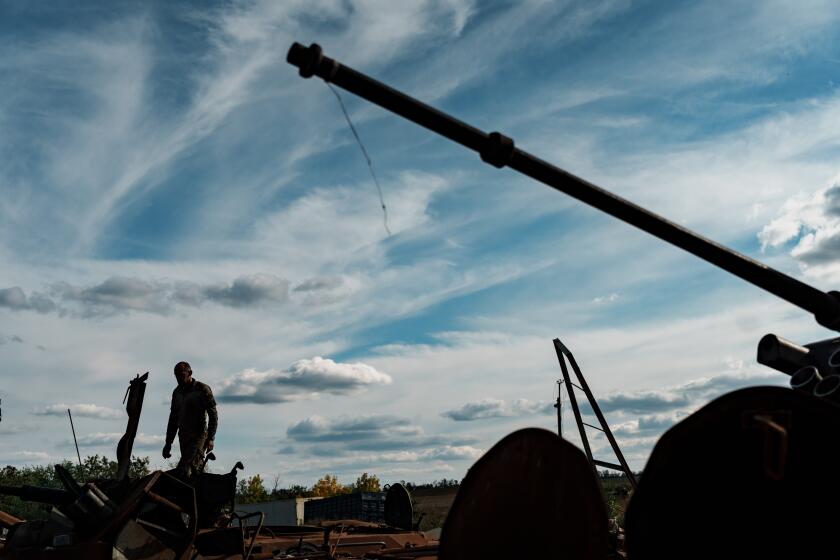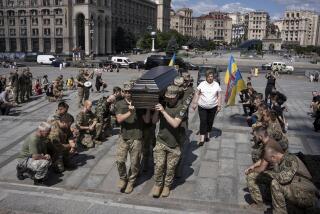Ukraine’s utilities threatened by Russia in war’s new phase

- Share via
KYIV, Ukraine — When a missile struck a power station less than a mile from his apartment on the outskirts of Kyiv, Ukraine, Oleksander Maystrenko didn’t panic, run to a bomb shelter or consider evacuating, even though he lives close to what suddenly has become the Russian military’s main target in the war: anything related to Ukraine’s vital infrastructure.
His neighbors also haven’t budged, despite the fact that Tuesday’s attack — marked by a loud explosion — killed three people, severely damaged two facilities inside the plant’s compound and temporarily knocked out power to about 50,000 households, according to Kyiv Mayor Vitali Klitschko.
“We aren’t afraid because we aren’t just prepared logistically; we are morally prepared,” Maystrenko said outside his apartment building, where he and two neighbors sat on a bench and smoked only hours after the attack.
Ukrainian forces have recently recaptured swaths of territory in northeast, east and south, sending Russian troops fleeing. But in ravaged towns, suffering doesn’t stop with occupation’s end.
This is what the latest phase of Russia’s nearly 8-month-old war in Ukraine looks like. Moscow has openly declared its intention to increasingly strike power stations, waterworks and other key infrastructure. One Ukrainian energy official said Wednesday that 40% of the country’s electric power system had been severely damaged, and President Volodymyr Zelensky said that Russian forces have destroyed 30% of Ukraine’s power stations since Oct. 10.
But Maystrenko and his neighbors say they are prepared.
If the Russians knock out the power, there are stocks of flashlights and candles, he said. If there’s no gas for stoves, he has a plan to build a rudimentary stove in front of the building’s entrance and use firewood that has been collected to heat it. Water has been bottled and jars of pickled vegetables and canned goods have been safely stored.
Everyone knows to have plenty of blankets and warm clothes for the winter, he added.
“It’s never been a secret that this power plant is a target, but we’ve been preparing since this war started,” Maystrenko said. The preparations have created a sense of community as well as a united front among neighbors, who once knew each other only in passing and are facing a common enemy, he said.
The attacks have come at a critical time, with winter approaching. Klitschko said that Thursday marks the start of the heating season for Kyiv, which like most urban centers in Ukraine and even Russia uses a Soviet-era central system controlled by the city that provides heat for apartment buildings and businesses.
Following a meeting between Zelensky, government ministers, members of energy enterprises and some local officials, presidential advisor Kyrylo Tymoshenko said there would be power supply restrictions across Ukraine from 7 to 11 a.m. beginning Thursday, along with the use of street lights being limited in some cities.
“Please take this seriously,” Tymoshenko said on his Telegram channel. “This applies to residents of ALL regions of the country. ... These are forced steps. Therefore, we all work together on our front!”
Rights groups say Moscow’s practice of transporting captured Ukrainian civilians to Russia is illegal under international law. Hundreds, perhaps thousands, have vanished from Russian-occupied areas.
One area where power and water were reported knocked out by shelling was Enerhodar, the southern city next to the Zaporizhzhia nuclear power plant, one of the war’s most worrisome flashpoints. Missiles also severely damaged an energy facility near Zelensky’s hometown of Kryvyi Rih in south-central Ukraine, cutting power to villages, towns and to one city district, the regional governor said.
Using energy supplies as a weapon isn’t a new tactic for the Kremlin, particularly when it comes to Ukraine.
“Energy was always quite a holy cow for the Russians, and they claim that by controlling energy they can control the country,” said Hanna Shelest, the director of security programs at Foreign Policy Council Ukrainian Prism, based in Kyiv.
Russian President Vladimir Putin, who declared martial law in four illegally annexed regions of Ukraine, has used his ability to turn off the gas that passes through the country’s extensive, Soviet-era pipeline as leverage. His tactic has been used not just against the government in Kyiv, but also against energy-dependent nations in Europe, who built pipelines via the Baltic Sea for Russian gas.
Under its new strategy, the Russian military hopes to destroy enough of Ukraine’s infrastructure to make life so intolerable that residents will blame their own government, Shelest said.
Putin has called Ukraine a failed state and a historical part of Russia. In trying to make Ukrainians suffer, he hopes they will believe him, she said.
“What we see now is that it is definitely not working so well,” Shelest said, adding that Ukrainians are increasingly directing their rage at Putin.
Zelensky’s admission that Russia had knocked out nearly a third of Ukraine’s power stations was noteworthy, said Mason Clark, an analyst at the Washington-based Institute for the Study of War.
“If the Russians can keep up that sustained damage, and the Ukrainians can’t repair it, that could actually start to have an effect,” he said.
Clark said he didn’t believe Russia would be able to affect the Ukrainian population’s overwhelming support for their military in taking back the territory seized by Moscow.
Recent attacks by what Kyiv describes as Iranian-supplied drones and missiles against civilian housing and other nonmilitary targets “seem to be just terror attacks, essentially to try to intimidate the Ukrainian population,” he said.
Russia has used such scare tactics throughout the war out of “a misguided belief that they will be able to force the Ukrainians to surrender and force negotiations,” Clark said.
From a military sense, Russia’s use of the Iranian-supplied drones and Kalibr and Iskander cruise missiles against Ukrainian infrastructure is a “very poor use of limited-precision munitions,” Clark said.
The Russians are struggling with dwindling supplies of these high-end weapons, he said, adding that a more strategic move would be to save them for the battlefield, because Ukraine’s air defenses have succeeded in intercepting and shooting down many of the drones.
“It’s a waste by the Russians of very expensive and limited systems in an attempt to likely achieve a terror effect that isn’t going to sway the Ukrainian government or population,” Clark said.
Russia’s invasion of Ukraine has upended the operations of what was the world’s fourth-largest grain exporter, with global consequences.
Repairing infrastructure often falls to local administrations to handle. The port city of Odesa in southern Ukraine designated crews to help neighboring Mykolaiv, which has been under Russian bombardment for weeks.
In the Kharkiv region, government official Roman Semenukha said Sunday that while repairs to heating systems were underway around the recently liberated city of Kupiansk, it’s a slow process that first must restore electricity, gas and water.
“I want to emphasize that private households will be connected to the gas supply, but the situation with high-rise buildings is a bit more complicated, for various reasons,” said Andrii Besedin, an advisor to the head of the Kharkiv military administration.
Regional authorities in Kharkiv also are assessing the need for firewood, Besedin said, adding that warming shelters will be set up and authorities would offer to evacuate those who want to leave for the winter.
“Those who wish to do so [will move] to safe areas, where there are all communications. We will work every day to restore the critical infrastructure of these networks,” he said.
More to Read
Sign up for Essential California
The most important California stories and recommendations in your inbox every morning.
You may occasionally receive promotional content from the Los Angeles Times.













